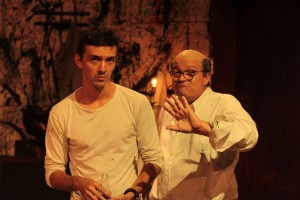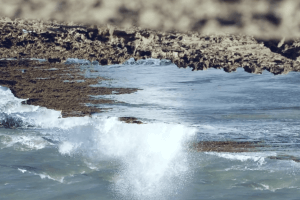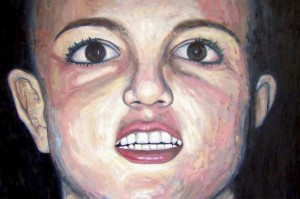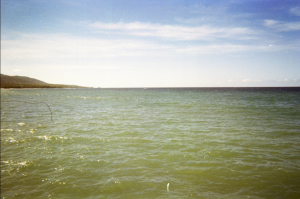
Rigor Mortis; a digital photograph of about 84 by 97 centimeters shows my two arms. One in normal state; the other numb, cold, purple, blue, green, cadaverous, dead. Both resting on white linen, reminiscent of a shroud, perhaps like the Shroud of Turin, that forgery in which many still believe to see the reliable miraculous impression of the controversial Nazarene.
My left arm reached the state seen in the photograph by placing a tourniquet under my shoulder for several minutes. Some time later, when for medical reasons I had to get my blood drawn, I noticed that in the labs they tie it to you gently: it’s just a slight pressure that makes the blood jostle where the nurse will puncture you. Well, in the photographic session that originated this piece, as in the series of performances and videos of the Rigor Mortis family, I tied the tourniquet as if I was going to amputate my limb –so strongly that it doesn’t take long for it to start fading. When the pressure is released, it leaves colorful purple stripes that for some reason amuse me as they appear, and give me nostalgia when they turn olive green until they vanish.
Rigor Mortis is about death. We are going to die, we know that, but it seems that most human beings believe that they will live on after death, whether in another earthly life or, even more graciously, that they will live eternally on another plane: suffering without any rest, or happy, free from any obstacle or challenge. They seek to overcome two fears: natural fear of death, which is almost genetic, limbic, an instinct for survival, similar to when the trachea closes automatically when you submerge in water. The other fear is a little more complex: the fear that life has no meaning; that all this so-called life is as insignificant as a navel lint; that all that is done, all the achievements, riches and moments disappear like the flesh on the bones. Let them be dust. May the good and the bad receive the same prize at the end: nothing.
A friend once told me, while drinking beer at Kuan Hua, a Chinese restaurant: «Life must have meaning.» What is the meaning of life? The words that follow this question will never fill the gap that opens. Are there people who blindly believe in a specific meaning of life? Is there anyone who does not hesitate for a moment? I believe that the meaning of life is measured by the conception of death.
You can believe what you want, but death is there. The end of your life. It is always close, never far away. It is on the edge of a window or on the bumper of a drunk driver. It’s in the weapon of a criminal or in the strong waves of the coast.
I have always been passionate about the strength that some people can have in the face of imminent death. I wonder how a soldier feels minutes before the battle and seconds after he has started, or whether there will be a difference between the emotions of a soldier running from trench to trench during World War II or that of a Roman legionary in the forefront, knowing he will be the first to die.
Few things are as sublime as the harsh truth that a good leader or ruler is a person who has the guts and decision to send many to die, or all the same, to kill. If you aspire to power, you must be ready to order to kill, order to die. However, that alone does not make you a good ruler. The key is to know when it is necessary for others to die at your command.
In our country, there are rulers who prefer to let people die rather than let them glimpse their own inability and awkwardness, terms that are too great for them. Faced with a health crisis caused by their idiocy, many benefactors abroad gathered medical supplies and sent them to our country to help people cope. The rulers said, «No, this shit does not come in here. It leaves us in evidence. This medicine does not come here.» People are dying, while they are getting fat.
I must confess that I really like my piece. This is not related to quality, or admiration. Rather, it stems from the feeling that it is a piece of my mind made into image. The feeling of seeing a piece of your mind on a wall is funny. Most of my artistic production is done live, it’s performance. I do not see it, but I see through it, while I do it. With Rigor Mortis I see a piece of my consciousness translated onto an image, summarizing ineffable connections, undocumented meditations and feelings that make logic fall short. It’s an enigmatic and captivating sensation. Some would call it narcissistic, and maybe someone has a problem with that.
In my case, no. I do not know if I’m a narcissist. I can contemplate my piece for long periods of time. I made an image that I thought should exist. The work I wanted to see, the one I needed to see, and now it exists.
Made to measure, to satisfy my expressive needs, to say what I can not say, to die without losing life and to rise without going down to the grave.
*About the artist:
Carlos Salazar Lermont (Caracas, 1987) is an artist and producer, specialized in performance art and works derived from action developed through photography, video, installation, and intervention. He obtained a BFA in Fine Arts with a major in Sculpture from UNEARTE (2012), and also graduated from the Cristóbal Rojas School of Visual Arts (2005). In 2013, he received an Honorable Mention in the XVII Salon Jóvenes con FIA and another one in 2014’s Salón Jóvenes con FIA 2.0/3, plus an Honorable Mention for his international curatorship Challenge the Power in the III International Biennial of Contemporary Art of the Andes. He has participated in several international events such as Encuentros de la Carne (Lima and Trujillo, Peru, 2015), Soap Box Sessions (London, UK, 2015), PAEkort # 14 (Rotterdam, The Netherlands, 2014) Rapid Pulse International Performance Art Festival (Chicago, United States, 2013), TRAMPOLIM meeting platform for performance art (Vitoria, Brazil, 2011), NADAQUEVER (Argentina, 2011), HORASperdidas (Monterrey, Mexico, 2010), and Performar (Santo Domingo, República Dominicana, 2009). In Venezuela, he participated in Obra Abierta: Ejes de Libertad, ID Performance, Encuentro de Arte Corporal, Velada de Santa Lucía, Fugaz: Feria de Performance in Lara, NOMASDECINCO, PerfoChoroní, and several others. He co-founded the arts collective Arte Acción La Evidencia de lo Inusual (Action Art: The Evidence of the Unusual) (2008-2010). In 2013, he founded the organization P3 Plataforma para Performance, to support creation, promotion, research, and training in performance art. In 2015, Salazar created the International Performance Biennial of Caracas. Currently, he is completing a double Master’s degree in Administration and Politics of Art and History, and Theory and Criticism of Modern and Contemporary Art at the School of the Art Institute of Chicago, thanks to the New Artist Society grant awarded by the same institution.
Página web: carloszamuro.blogspot.com















